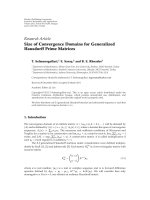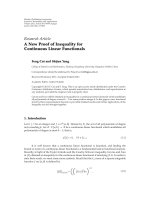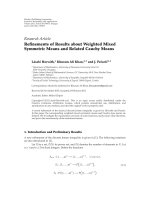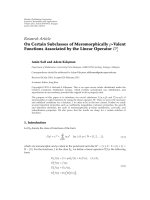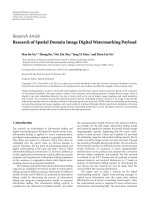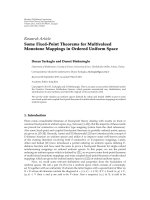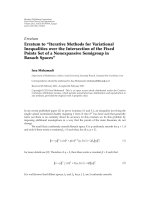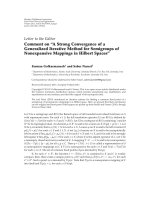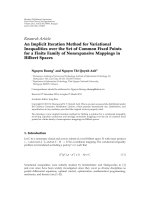Hindawi Publishing Corporation Boundary Value Problems Volume 2011, Article ID 279752, 11 pages pdf
Bạn đang xem bản rút gọn của tài liệu. Xem và tải ngay bản đầy đủ của tài liệu tại đây (492.84 KB, 11 trang )
Hindawi Publishing Corporation
Boundary Value Problems
Volume 2011, Article ID 279752, 11 pages
doi:10.1155/2011/279752
Research Article
Positive Solutions for Third-Order p-Laplacian
Functional Dynamic Equations on Time Scales
Changxiu Song and Xuejun Gao
School of Applied Mathematics, Guangdong University of Technology, Guangzhou 510006, China
Correspondence should be addressed to Changxiu Song,
Received 31 March 2010; Revised 8 December 2010; Accepted 9 December 2010
Academic Editor: Daniel Franco
Copyright q 2011 C. Song and X. Gao. This is an open access article distributed under the Creative
Commons Attribution License, which permits unrestricted use, distribution, and reproduction in
any medium, provided the original work is properly cited.
The authors study the boundary value problems for a p-Laplacian functional dynamic equation on
a time scale, φ
p
x
Δ∇
t
∇
atfxt,xμt 0, t ∈ 0,T, x
0
tψt, t ∈ −r, 0, x
Δ
0
x
Δ∇
00, xTB
0
x
Δ
η 0. By using the twin fixed-point theorem, sufficient conditions are
established for the existence of twin positive solutions.
1. Introduction
Let T be a closed nonempty subset of R, and let T have the subspace topology inherited from
the Euclidean topology on R. In some of the current literature, T is called a time scale or
measure chain. For notation, we shall use the convention that, for each interval of J of R, J
will denote time scales interval, that is, J : J ∩ T.
In this paper, let T be a time scale such that −r,0,T ∈ T. We are concerned with the
existence of positive solutions of the p-Laplacian dynamic equation on a time scale
φ
p
x
Δ∇
t
∇
a
t
f
x
t
,x
μ
t
0,t∈
0,T
,
x
0
t
ψ
t
,t∈
−r, 0
,x
Δ
0
x
Δ∇
0
0,x
T
B
0
x
Δ
η
0,
1.1
where φ
p
u is the p-Laplacian operator, that is, φ
p
u|u|
p−2
u, p>1, φ
p
−1
uφ
q
u,
where 1/p 1/q 1; η ∈ 0,ρT and
H
1
the function f : R
2
→ R
is continuous,
H
2
the function a :T → R
is left dense continuous i.e., a ∈ C
ld
T, R
and does not
vanish identically on any closed subinterval of 0,T. Here, C
ld
T, R
denotes the
set of all left dense continuous functions from T to R
,
2 Boundary Value Problems
H
3
ψ : −r, 0 → R
is continuous and r>0,
H
4
μ : 0,T → −r, T is continuous, μt ≤ t for all t,
H
5
B
0
:R → R is continuous and satisfies that there are β ≥ δ ≥ 0 such that
δs ≤ B
0
s
≤ βs, for s ∈ R
. 1.2
p-Laplacian problems with two-, three-, m-point boundary conditions for ordinary
differential equations and finite difference equations have been studied extensively, for
example see 1–4 and references therein. However, there are not many concerning the p-
Laplacian problems on time scales, especially for p-Laplacian functional dynamic equations
on time scales.
The motivations for the present work stems from many recent investigations in 5–
8 and references therein. Especially, Kaufmann and Raffoul 8 considered a nonlinear
functional dynamic equation on a time scale and obtained sufficient conditions for the
existence of positive solutions. In this paper, we apply the twin fixed-point theorem to obtain
at least two positive solutions of boundary value problem BVP for short1.1 when growth
conditions are imposed on f. Finally, we present two corollaries, which show that under the
assumptions that f is superlinear or sublinear, BVP 1.1 has at least two positive solutions.
Given a nonnegative continuous functional γ on a cone P of a real Banach space E,we
define for each d>0thesets
P
γ,d
x ∈ P : γ
x
<d
,
∂P
γ,d
x ∈ P : γ
x
d
,
Pγ,d
x ∈ P : γ
x
≤ d
.
1.3
The following twin fixed-point lemma due to 9 will play an important role in the
proof of our results.
Lemma 1.1. Let E be a real Banach space, P a cone of E, γ and α two nonnegative increasing
continuous functionals, θ a nonnegative continuous functional, and θ00. Suppose that there
are two positive numbers c and M such that
γ
x
≤ θ
x
≤ α
x
,
x
≤ Mγ
x
, for x ∈
Pγ,c
.
1.4
F :
Pγ,c → P is completely continuous. There are positive numbers 0 <a<b<csuch that
θ
λx
≤ λθ
x
, ∀λ ∈
0, 1
,x∈ ∂P
θ, b
, 1.5
and
i γFx >cfor x ∈ ∂Pγ,c,
ii θFx <bfor x ∈ ∂Pθ, b,
iii αFx >aand Pα, a
/
∅ for x ∈ ∂P α, a.
Boundary Value Problems 3
Then, F has at least two fixed points x
1
and x
2
∈ Pγ,c satisfying
a<α
x
1
,θ
x
1
<b, b<θ
x
2
,γ
x
2
<c. 1.6
2. Positive Solutions
We note that xt is a solution of 1.1 if and only if
x
t
⎧
⎪
⎪
⎪
⎪
⎪
⎪
⎪
⎪
⎪
⎪
⎪
⎪
⎪
⎨
⎪
⎪
⎪
⎪
⎪
⎪
⎪
⎪
⎪
⎪
⎪
⎪
⎪
⎩
T
0
T − s
φ
q
s
0
a
r
f
x
r
,x
μ
r
∇r
∇s
−B
0
η
0
φ
q
s
0
− a
r
f
x
r
,x
μ
r
∇r
∇s
t
0
t − s
φ
q
s
0
− a
r
f
x
r
,x
μ
r
∇r
∇s, t ∈
0,T
,
ψ
t
,t∈
−r, 0
.
2.1
Let E C
Δ
ld
0,T, R be endowed with the norm x max
t∈0,T
|xt| and P {x ∈ E : x is
concave and nonnegative valued on 0,T,andx
Δ
00}.
Clearly, E is a Banach space with the norm x and P is a cone in E. For each x ∈ E,
extend xt to −r, T with xtψt for t ∈ −r, 0.
Define F : P → E as
Fx
t
T
0
T − s
φ
q
s
0
a
r
f
x
r
,x
μ
r
∇r
∇s
− B
0
η
0
φ
q
s
0
−a
r
f
x
r
,x
μ
r
∇r
∇s
t
0
t − s
φ
q
s
0
−a
r
f
x
r
,x
μ
r
∇r
∇s, t ∈
0,T
.
2.2
We seek a fixed point, x
1
,ofF in the cone P . Define
x
t
⎧
⎨
⎩
x
1
t
,t∈
0,T
,
ψ
t
,t∈
−r, 0
.
2.3
Then, xt denotes a positive solution of BVP 1.1.
It follows from 2.2 that
Lemma 2.1. Let F be defined by 2.2.Ifx ∈ P,then
i FP ⊂ P.
ii F : P → P is completely continuous.
4 Boundary Value Problems
iii xt ≥ T − t/Tx, t ∈ 0,T.
iv xt is decreasing on 0,T.
The proof is similar to the proofs of Lemma 2.3 and Theorem 3.1 in 7, and is omitted.
Fix l ∈ T such that 0 <l<η<T,andset
Y
1
:
t ∈
0,T
: μ
t
< 0
,Y
2
:
t ∈
0,T
: μ
t
≥ 0
,Y
3
: Y
1
∩
0,l
. 2.4
Throughout this paper, we assume Y
3
/
∅ and
Y
3
φ
q
s
0
ar∇r∇s>0.
Now, we define the nonnegative, increasing, continuous functionals γ, θ,andα on P
by
γ
x
max
t∈
l,η
x
t
x
l
,
θ
x
min
t∈
0,l
x
t
x
l
,
α
x
max
t∈
η,T
x
t
x
η
.
2.5
We have
γ
x
θ
x
≤ α
x
,x∈ P,
θ
x
γ
x
x
l
≥
T − l
T
x
,α
x
x
η
≥
T − η
T
x
, for each x ∈ P.
2.6
Then,
x
≤
T
T − l
γ
x
,
x
≤
T
T − η
α
x
, for each x ∈ P.
2.7
We also see that
θ
λx
λθ
x
, ∀λ ∈
0, 1
,x∈ ∂P
θ, b
. 2.8
For the notational convenience, we denote σ
1
, σ
2
and ρ
1
, ρ
2
by
σ β
Y
3
φ
q
s
0
a
r
∇r
∇s; ρ T
2T δ
φ
q
T
0
a
r
∇r
. 2.9
Theorem 2.2. Suppose that there are positive numbers a<b<csuch that
0 <a<
σ
ρ
b<
T − l
σ
Tρ
c.
2.10
Boundary Value Problems 5
Assume f satisfies the following conditions:
A fx, ψs >φ
p
c/σ for c ≤ x ≤ T/T − lc, uniformly in s ∈ −r, 0,
B fx, ψs <φ
p
b/ρ for 0 ≤ x ≤ T/T − lb, uniformly in s ∈ −r, 0,
f
x
1
,x
2
<φ
p
b
ρ
, for 0 ≤ x
i
≤
T
T − l
b, i 1, 2, 2.11
C fx, ψs >φ
p
a/σ for a ≤ x ≤ T/T − ηa, uniformly in s ∈ −r, 0.
Then, BVP 1.1 has at least two positive solutions of the form
x
t
⎧
⎨
⎩
ψ
t
,t∈
−r, 0
,
x
i
t
,t∈
0,T
,i 1, 2,
2.12
where a<max
t∈η,T
x
1
t, min
t∈0,l
x
1
t <band b<min
t∈0,l
x
2
t, max
t∈l,η
x
2
t <c.
Proof. By the definition of operator F and its properties, it suffices to show that the conditions
of Lemma 1.1 hold with respect to F.
First, we verify that x ∈ ∂Pγ,c implies γFx >c.
Since γxxlc,onegetsxt ≥ c for t ∈ 0,l. Recalling that 2.7,weknowc ≤ x ≤
T/T − lc for t ∈ 0,l. Then, we get
γ
Fx
T
0
T − s
φ
q
s
0
a
r
f
x
r
,x
μ
r
∇r
∇s
− B
0
η
0
φ
q
s
0
−a
r
f
x
r
,x
μ
r
∇r
∇s
l
0
l − s
φ
q
s
0
−a
r
f
x
r
,x
μ
r
∇r
∇s
≥−B
0
η
0
φ
q
s
0
−a
r
f
x
r
,x
μ
r
∇r
∇s
≥ β
l
0
φ
q
s
0
a
r
f
x
r
,x
μ
r
∇r
∇s
≥ β
Y
3
φ
q
s
0
a
r
f
x
r
,ψ
μ
r
∇r
∇s
>β
Y
3
φ
q
s
0
a
r
∇r
∇s
c
σ
c.
2.13
Secondly, we prove that x ∈ ∂Pθ, b implies θFx <b.
Since θxb implies xlb, it holds that b ≤ xt ≤x≤T/T −lθxT/T −lb
for t ∈ 0,l,andforallx ∈ ∂P θ, b implies
0 ≤ x
t
≤ b, for t ∈
l, T
. 2.14
6 Boundary Value Problems
Then,
0 ≤ x
t
≤
T
T − l
b, t ∈
0,T
.
2.15
So, we have
θ
Fx
T
0
T − s
φ
q
s
0
a
r
f
x
r
,x
μ
r
∇r
∇s
− B
0
η
0
φ
q
s
0
−a
r
f
x
r
,x
μ
r
∇r
∇s
l
0
l − s
φ
q
s
0
−a
r
f
x
r
,x
μ
r
∇r
∇s
<
T
0
Tφ
q
T
0
a
r
f
x
r
,x
μ
r
∇r
∇s δ
T
0
φ
q
T
0
a
r
f
x
r
,x
μ
r
∇r
∇s
T
0
Tφ
q
T
0
a
r
f
x
r
,x
μ
r
∇r
∇s
T
2T δ
φ
q
Y
1
a
r
f
x
r
,ψ
μ
r
∇r
Y
2
a
r
f
x
r
,x
μ
r
∇r
<
b
ρ
T
2T δ
φ
q
T
0
a
r
∇r
b.
2.16
Finally, we show that
P
α, a
/
∅,α
Fx
>a, ∀x ∈ ∂P
α, a
. 2.17
It is obvious that Pα, a
/
∅. On the other hand, αxxηa and 2.7 imply
a ≤ x ≤
T
T − η
a, for t ∈
0,η
.
2.18
Thus,
α
Fx
T
0
T − s
φ
q
s
0
a
r
f
x
r
,x
μ
r
∇r
∇s
− B
0
η
0
φ
q
s
0
−a
r
f
x
r
,x
μ
r
∇r
∇s
η
0
η − s
φ
q
s
0
−a
r
f
x
r
,x
μ
r
∇r
∇s
Boundary Value Problems 7
≥−B
0
η
0
φ
q
s
0
−a
r
f
x
r
,x
μ
r
∇r
∇s
≥ β
l
0
φ
q
s
0
a
r
f
x
r
,x
μ
r
∇r
∇s
≥ β
Y
3
φ
q
s
0
a
r
f
x
r
,ψ
μ
r
∇r
∇s
>β
Y
3
φ
q
s
0
a
r
∇r
∇s
a
σ
a.
2.19
By Lemma 1.1, F has at least two different fixed points x
1
and x
2
satisfying
a<α
x
1
,θ
x
1
<b, b<θ
x
2
,γ
x
2
<c. 2.20
Let
x
t
⎧
⎨
⎩
ψ
t
,t∈
−r, 0
,
x
i
t
,t∈
0,T
,i 1, 2,
2.21
which are twin positive solutions of BVP 1.1. The proof is complete.
In analogy to Theorem 2.2, we have the following result.
Theorem 2.3. Suppose that there are positive numbers a<b<csuch that
0 <a<
T − η
T
b<
T − η
σ
Tρ
c.
2.22
Assume f satisfies the following conditions:
A’ fx, ψs <φ
p
c/ρ for 0 ≤ x ≤ T/T − lc, uniformly in s ∈ −r, 0,
f
x
1
,x
2
<φ
p
c
ρ
, for 0 ≤ x
i
≤
T
T − l
c, i 1, 2,
2.23
B’ fx, ψs >φ
p
b/σ for b ≤ x ≤ T/T − lb, uniformly in s ∈ −r, 0,
C’ fx, ψs <φ
p
a/ρ for 0 ≤ x ≤ T/T − ηa, uniformly in s ∈ −r, 0,
f
x
1
,x
2
<φ
p
a
ρ
, for 0 ≤ x
i
≤
T
T − η
a, i 1, 2.
2.24
8 Boundary Value Problems
Then, BVP 1.1 has at least two positive solutions of the form
x
t
⎧
⎨
⎩
ψ
t
,t∈
−r, 0
,
x
i
t
,t∈
0,T
,i 1, 2.
2.25
Now, we give theorems, which may be considered as the corollaries of Theorems 2.2
and 2.3.
Let
f
0
lim
x →0
f
x, ψ
s
x
p−1
,f
∞
lim
x →∞
f
x, ψ
s
x
p−1
,f
00
lim
x
1
→0
;x
2
→0
f
x
1
,x
2
max
x
p−1
1
,x
p−1
2
,
2.26
and choose k
1
, k
2
, k
3
such that
k
1
σ>1,k
2
σ>1, 0 <k
3
ρ<
T − η
T
.
2.27
From above, we deduce that 0 <k
3
ρ<l/T.
Theorem 2.4. If the following conditions are satisfied:
D f
0
>k
1
p−1
, f
∞
>k
2
p−1
, uniformly in s ∈ −r, 0,
E there exists a p
1
> 0 such that for all 0 ≤ x ≤ T/T − lp
1
, one has
f
x, ψ
s
<
p
1
ρ
p−1
, uniformly in s ∈
−r, 0
,
f
x
1
,x
2
<
p
1
ρ
p−1
, for 0 ≤ x
i
≤
T
T − l
p
1
,i 1, 2.
2.28
Then, BVP 1.1 has at least two positive solutions of the form
x
t
⎧
⎨
⎩
ψ
t
,t∈
−r, 0
,
x
i
t
,t∈
0,T
,i 1, 2.
2.29
Proof. First, choose b p
1
,onegets
f
x, ψ
s
<φ
p
b
ρ
, for 0 ≤ x ≤
T
T − l
b, uniformly in s ∈
−r, 0
,
f
x
1
,x
2
<φ
p
b
ρ
, for 0 ≤ x
i
≤
T
T − l
b, i 1, 2.
2.30
Boundary Value Problems 9
Secondly, since f
0
>k
p−1
1
, there is R
1
> 0sufficiently small such that
f
x, ψ
s
>
k
1
x
p−1
, for 0 ≤ x ≤ R
1
.
2.31
Without loss of generality, suppose R
1
≤ T − ησ/Tρb. Choose a>0sothata<
T − η/TR
1
. For a ≤ x ≤ T/T − ηa, we have x ≤ R
1
and a<σ/ρb.Thus,
f
x, ψ
s
>
k
1
x
p−1
≥
k
1
a
p−1
>φ
p
a
σ
, for a ≤ x ≤
T
T − η
a.
2.32
Thirdly, since f
∞
>k
2
p−1
, there is R
2
> 0sufficiently large such that
f
x, ψ
s
>
k
2
x
p−1
, for x ≥ R
2
.
2.33
Without loss of generality, suppose R
2
> T/T − lb. Choose c ≥ R
2
. Then,
f
x, ψ
s
>
k
2
x
p−1
≥
k
2
c
p−1
>φ
p
c
σ
, for c ≤ x ≤
T
T − l
c. 2.34
We get now 0 <a<σ/ρb<T −lσ/Tρc, and then the conditions in Theorem 2.2
are all satisfied. By Theorem 2.2,BVP1.1 has at least two positive solutions. The proof is
complete.
Theorem 2.5. If the following conditions are satisfied:
F f
0
<k
3
p−1
, uniformly in s ∈ −r, 0; f
00
<k
3
p−1
,
G there exists a p
2
> 0 such that for all 0 ≤ x ≤ T/T − lp
2
, one has
f
x, ψ
s
>
p
2
σ
p−1
, uniformly in s ∈
−r, 0
.
2.35
Then, BVP 1.1 has at least two positive solutions of the form
x
t
⎧
⎨
⎩
ψ
t
,t∈
−r, 0
,
x
i
t
,t∈
0,T
,i 1, 2.
2.36
The proof is similar to that of Theorem 2.4 and we omitted it.
The following Corollaries are obvious.
Corollary 2.6. If the following conditions are satisfied:
D’ f
0
∞, f
∞
∞, uniformly in s ∈ −r, 0,
10 Boundary Value Problems
E there exists a p
1
> 0 such that for all 0 ≤ x ≤ T/T − lp
1
, one has
f
x, ψ
s
<
p
1
ρ
p−1
, uniformly in s ∈
−r, 0
,
f
x
1
,x
2
<
p
1
ρ
p−1
, for 0 ≤ x
i
≤
T
T − l
p
1
,i 1, 2.
2.37
Then, BVP 1.1 has at least two positive solutions of the form
x
t
⎧
⎨
⎩
ψ
t
,t∈
−r, 0
,
x
i
t
,t∈
0,T
,i 1, 2.
2.38
Corollary 2.7. If the following conditions are satisfied:
F’ f
0
0, uniformly in s ∈ −r, 0, f
00
0;
G there exists a p
2
> 0 such that for all 0 ≤ x ≤ T/T − lp
2
, one has
f
x, ψ
s
>
p
2
σ
p−1
, uniformly in s ∈
−r, 0
.
2.39
Then, BVP 1.1 has at least two positive solutions of the form
x
t
⎧
⎨
⎩
ψ
t
,t∈
−r, 0
,
x
i
t
,t∈
0,T
,i 1, 2.
2.40
3. Example
Example 3.1. Let T −1/2, 0 ∪{1/2
n
: n ∈ N
0
}, at ≡ 1, r 1/2, η 1/2, p 3, B
0
xx.
We consider the following boundary value problem:
x
Δ∇
t
x
Δ∇
t
∇
10
4
x
3
t
x
3
t
x
3
t − 1/2
1
0,t∈
0, 1
,
x
0
t
ψ
t
≡ 0,t∈
−
1
2
, 0
,x
Δ
0
x
Δ∇
0
0,x
1
x
Δ
1
2
0,
3.1
where μ : 0, 1 → −1/2, 1 and μtt − 1/2; fx, ψs 6x
3
/x
3
1, fx
1
,x
2
6x
3
1
/x
3
1
x
3
2
1.
Choosing a 1/2 × 10
10
, b 1, c 10
3
, l 1/4, direct calculation shows that
Y
1
0,
1
2
,Y
2
1
2
, 1
,Y
3
0,
1
4
,σ
4
√
2
224
,ρ 3.
3.2
Boundary Value Problems 11
Consequently, 0 <a<T − η/Tb<T − ησ/Tρc and f satisfies
A’ fx, ψs <φ
p
c/ρ10
6
/9for0≤ x ≤ 4 × 10
3
/3, uniformly in s ∈ −1/2, 0,
f
x
1
,x
2
<φ
p
c
ρ
10
6
9
, for 0 ≤ x
i
≤
4 × 10
3
3
,i 1, 2,
3.3
B’ fx, ψs >φ
p
b/σ1/σ
2
for 1 ≤ x ≤ 4/3, uniformly in s ∈ −1/2, 0,
C’ fx, ψs <φ
p
a/ρ1/36 × 10
20
for 0 ≤ x ≤ 1/10
10
, uniformly in s ∈ −1/2, 0,
f
x
1
,x
2
<φ
p
a
ρ
1
36 × 10
20
, for 0 ≤ x
i
≤
1
10
10
,i 1, 2. 3.4
Then all conditions of Theorem 2.3 hold. Thus, with Theorem 2.3,theBVP3.1 has at least
two positive solutions.
Acknowledgment
This paper is supported by Grants nos. 10871052 and 10901060 from the NNSF of China,
and by Grant no. 10151009001000032 from the NSF of Guangdong.
References
1 R. Avery and J. Henderson, “Existence of three positive pseudo-symmetric solutions for a one-
dimensional p-Laplacian,” Journal of Mathematical Analysis and Applications, vol. 277, no. 2, pp. 395–404,
2003.
2 Y. Liu and W. Ge, “Twin positive solutions of boundary value problems for finite difference equations
with p-Laplacian operator,” Journal of Mathematical Analysis and Applications, vol. 278, no. 2, pp. 551–561,
2003.
3 A. Cabada, “Extremal solutions for the difference φ-Laplacian problem with nonlinear functional
boundary conditions,” Computers & Mathematics with Applications, vol. 42, no. 3–5, pp. 593–601, 2001.
4 F H. Wong, “Existence of positive solutions for m-Laplacian boundary value problems,” Applied
Mathematics Letters, vol. 12, no. 3, pp. 11–17, 1999.
5 E. R. Kaufmann, “Positive solutions of a three-point boundary-value problem on a time scale,”
Electronic Journal of Differential Equations, vol. 82, pp. 1–11, 2003.
6 Z. He, “Double positive solutions of three-point boundary value problems for p-Laplacian dynamic
equations on time scales,” Journal of Computational and Applied Mathematics, vol. 182, no. 2, pp. 304–315,
2005.
7 L. Bian, X. He, and H. Sun, “Multiple positive solutions of m-point BVPs for third-order p-Laplacian
dynamic equaitons on time scales,” Advance in Difference Equations, vol. 2009, Article ID 262857, 12
pages, 2009.
8 E. R. Kaufmann and Y. N. Raffoul, “Positive solutions for a nonlinear functional dynamic equation on
a time scale,” Nonlinear Analysis: Theory, Methods & Applications, vol. 62, no. 7, pp. 1267–1276, 2005.
9 R. I. Avery, C. J. Chyan, and J. Henderson, “Twin solutions of boundary value problems for ordinary
differential equations and finite difference equations,” Computers & Mathematics with Applications, vol.
42, no. 3–5, pp. 695–704, 2001.
